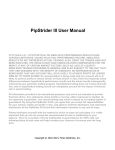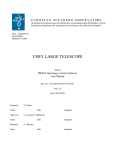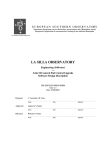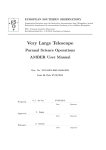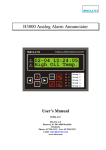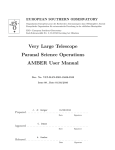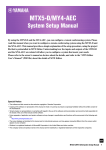Download OPD Controller (As-built) Software Detailed Design
Transcript
Accepted by ESO Technical Archive ESO Technical Archive 02.05.2008 ESO OPD Controller (As-built) Software Detailed Design Doc. Issue Date Page VLT-SPE-ESO-15420-4000 2 30/04/2008 2 of 30 CHANGE RECORD ISSUE DATE SECTION/PAGE AFFECTED REASON/INITIATION DOCUMENTS/REMARKS 1/prep.1 1/prep.2 1/prep.3 1/prep.4 1 2 14/08/2006 16/08/2006 20/08/2006 26/08/2006 31/08/2006 30/04/2008 All All 4.3 4.1 All All First draft Second draft prepared for review. Dedicated configuration database point. Add instrument OPD offset of the night. First release Update after integration of PRIMA changes and new vibration cancellation algorithm ESO OPD Controller (As-built) Software Detailed Design Doc. Issue Date Page VLT-SPE-ESO-15420-4000 2 30/04/2008 3 of 30 TABLE OF CONTENTS 1 INTRODUCTION 7 1.1 Purpose 7 1.2 Scope 7 1.3 Applicable Documents 7 1.4 Reference Documents 8 1.5 Acronyms 8 2 FUNCTIONAL SPECIFICATION 9 2.1 Overview 2.1.1 About OPD Sign Convention 2.1.2 Chopping 9 10 10 2.2 Software Requirements 10 2.3 Constraints and Performance 11 2.4 Design Decisions 11 3 ARCHITECTURE OVERVIEW 12 3.1 Hardware 12 3.2 Software 3.2.1 Application Package 3.2.2 Support Packages 3.2.3 CMM Modules 12 12 14 14 4 DESIGN DESCRIPTION 15 4.1 TAC Real-Time Algorithm 4.1.1 TAC Algorithm Structure 4.1.2 Fringe Tracking with an Instrument Only (i.e. VINCI or MIDI) 4.1.3 Fringe Tracking with FINITO or PRIMA (incl. ZPD Search) 4.1.4 Vibration Tracking 4.1.5 TAC Specific Function Block 15 15 16 16 18 19 4.2 Commands 4.2.1 Standard Commands (with application-specific extended behaviour) 4.2.2 Public Commands 4.2.3 Maintenance Commands 4.2.4 Test Commands 21 21 21 21 21 4.3 Online Database 4.3.1 Control Branch 4.3.2 Configuration Branch 4.3.3 Data Branch 22 22 22 22 ESO OPD Controller (As-built) Software Detailed Design 5 APPENDIX Doc. Issue Date Page VLT-SPE-ESO-15420-4000 2 30/04/2008 4 of 30 24 5.1 CDT and CIT files 5.1.1 opdcPublic.cdt 5.1.2 opdcTest.cdt 5.1.3 opdcSoftDev.cit 24 24 26 26 5.2 Online Database Description Files 5.2.1 opdcDB_CONFIG.class 5.2.2 opdcDB_DATA.class 27 27 28 ESO OPD Controller (As-built) Software Detailed Design Doc. Issue Date Page VLT-SPE-ESO-15420-4000 2 30/04/2008 5 of 30 TABLE OF FIGURES Figure 1: Schematic Layout of the Fringe Tracking Facility using FINITO............................................9 Figure 2: OPDC LCU Hardware structure..............................................................................................12 Figure 3: TAC Algorithm Schematic (1 DL, 1 FTK channel only)........................................................15 Figure 4: FTK state machine...................................................................................................................16 Figure 5: ZPD search trajectory..............................................................................................................17 ESO OPD Controller (As-built) Software Detailed Design Doc. Issue Date Page VLT-SPE-ESO-15420-4000 2 30/04/2008 6 of 30 This page has been left intentionally blank. ESO 1 1.1 OPD Controller (As-built) Software Detailed Design Doc. Issue Date Page VLT-SPE-ESO-15420-4000 2 30/04/2008 7 of 30 Introduction Purpose This document aims to present the design of the OPD Controller Software that is part of the VLTI Fringe Tracking (FTK) Facility. 1.2 Scope This document shall first shortly describe the VLTI Fringe Tracking Facility and the function of the OPDC LCU therein. It will then present the requirements and constraints associated to this software component. Some design decisions are then issued from these requirements. In order to ensure compliancy with LCU standard interface and behaviour described in [AD#01], the code of this software component was first generated from LCU Server Framework (LSF) template and extended following the guidelines documented in [AD#03]. The LCC libraries, messaging system and database are documented in [AD#02]. The implementation of the OPDC real-time algorithm relies on Tools for Advanced Control (TAC) application described in [AD#04]. The design description section of this document mainly focuses on the application-specific extensions brought to LSF and on the description of the real-time algorithm. In addition, the reader should be familiar with VLT software standards. 1.3 Applicable Documents The following documents, of the issue shown if specified, form part of this manual to the extent specified herein. In the event of conflict between this document and those referenced, the content of this document shall be considered as a superseding requirement unless explicitly stated otherwise herein. Reference Document Number Issue Date [AD#01] VLT-MAN-ESO-17210-0667 1.0 [AD#02] [AD#03] [AD#04] [AD#05] [AD#06] VLT-MAN-SBI-17210-0001 VLT-MAN-ESO-17210-2252 VLT-MAN-ESO-17210-2970 VLT-MAN-ESO-17210-3525 VLT-SPE-ESO-15400-1954 3.5 2 2 1 1.0 [AD#07] VLT-SPE-ESO-15400-4558 1 Title 03/12/1996 Guidelines for the Development of VLT Application Software 20/10/1999 LCU Common Software User Manual 05/07/2002 LCU Server Framework User Manual 21/03/2004 Tools for Advanced Control User Manual 27/01/2005 RTDScope User Manual 09/11/1999 ICD between VLTI Fast Link and DL, OPDC, FSU and Instruments 30/04/2008 Adaptive RLS Vibration Cancellation Algorithm ESO 1.4 OPD Controller (As-built) Software Detailed Design Doc. Issue Date Page VLT-SPE-ESO-15420-4000 2 30/04/2008 8 of 30 Reference Documents The following documents contain additional information that can be useful to the reader: Reference Document Number Issue Date [RD#01] VLT-SPE-ESO-15430-2790 1 [RD#02] VLT-SPE-ESO-15420-4001 1 31/08/2006 FINITO Detection Algorithm (As-built) Control Software Detailed Design 31/08/2006 OPD Monitor (As-built) Software Detailed Design 1.5 Title Acronyms This document employs several abbreviations and acronyms to refer concisely to an item, after it has been introduced. The following list is aimed to help the reader in recalling the extended meaning of each short expression: Acronym Meaning AD ADU CPU DD DL FTK LCU LCC LSF IC IO ISR OPD OPDC OPDM PPC RD RMN RFM RMS RT RTC SNR SR TAC TIM UTC VLT VLTI VTK ZPD Applicable Document Astronomical Detector Unit Central Processing Unit Design Decision Delay Line Fringe Tracking Local Control Unit LCU Common Software LCU Server Framework Laboratory Input Channel Input/Output Interrupt Service Routine Optical Path Difference OPD Controller OPD Monitor Power PC Reference Document Reflective Memory Network Reflective Memory Network, 2nd generation Root Mean Square Real-Time RT Controller Signal to Noise Ratio Software Requirement Tools for Advanced Control Time Interface Module Universal Time Coordinated Very Large Telescope VLT Interferometer Vibration Tracking Zero Path Difference ESO OPD Controller (As-built) Software Detailed Design Doc. Issue Date Page VLT-SPE-ESO-15420-4000 2 30/04/2008 9 of 30 2 Functional Specification 2.1 Overview Fringe motion happens with earth rotation and any type of disturbance. The latter is not predictable, needs to be measured and compensated to minimize the residual fringe motion seen by the VLTI instruments; it is the purpose of the VLTI Fringe Tracking Facility. The facility currently encompasses one fringe sensor, i.e. FINITO or PRIMA, a set of Delay Lines (DL) and one dynamic compensator, i.e. the OPD Controller (OPDC). The LCU associated to the previous components are all interconnected by means of a fast communication link featuring real-time capabilities, i.e. the VLTI Fast Link or Reflective Memory Network (RMN). MIDI and VINCI instruments are also present on the RMN to allow some level of fringe tracking without FINITO. The OPDC does not support concurrent observations; only one fringe sensor is enabled at a time. It is capable of providing FTK for two baselines/three telescopes (i.e. triangle, possibly collapsed) at the same time when using FINITO as a fringe sensor. The OPDC has been extended to handle one PRIMA FSU, which is handled similarly as one FINITO channel. Figure 1: Schematic Layout of the Fringe Tracking Facility using FINITO The VLTI is suffering from atmospheric piston, but also piston induced by vibrations of components in the optical train; the latter being periodic, it can be modeled and compensated by an adaptive vibration cancellation (a.k.a. tracking, VTK) algorithm (see [AD#07]). The function of the OPDC is threefold: • • • Propagate the VINCI or MIDI instrument fringe offset to the tracking delay line (with adequate sign). In this mode, the OPDC acts only as a switchyard; the instrument drives the tracking DL to search and center fringes. Provide FTK capabilities with FINITO or PRIMA. In this mode, the OPDC is responsible to search, detect and track fringes using the signals measured by FINITO/PRIMA. Provide VTK capabilities with FINITO/PRIMA. ESO 2.1.1 OPD Controller (As-built) Software Detailed Design Doc. Issue Date Page VLT-SPE-ESO-15420-4000 2 30/04/2008 10 of 30 About OPD Sign Convention FINITO, PRIMA or the VLTI instruments are providing a fringe position error signal, the sign of which depends on how the beams are routed in the laboratory; i.e. the OPD provided by the instrument/FINITO is defined as the OPL of the beam, propagating in the laboratory, closest to the tunnel minus the OPL of the other beam. E.g. if we consider the case of UT1-DL1-IC1 and UT2-DL2IC3 feeding MIDI instrument, the OPD computed by MIDI should be OPL(UT1)-OPL(UT2); if the reference DL is DL1, the centering offset is applied to DL2 OPL position with the same sign (positive OPD means the OPL of UT1 beam is greater than the one of UT2, the fringes are centered by increasing DL2 OPL, hence the positive sign); if for operational reasons the reference DL is DL2, the same centering offset should be applied to DL1 with opposite sign. The OPDC provides a mechanism to change the sign of the fringe centering offset depending on the interferometer configuration. 2.1.2 Chopping An instrument like MIDI requires chopping to measure the flux of the scientific target. A mode of MIDI considers acquiring fringes with parallel photometry. Therefore, the telescope might be chopping while FTK. The OPDC must suspend the FTK loop when the telescopes are pointing to the sky and resume it when pointing to the target. The telescopes can operate in two different chopping/guiding mode: • The telescope points by default to the target and M2 periodically offsets to the sky. The target light is propagated to the VLTI when M2 is in its center position. The telescope points by default to the sky and M2 periodically offsets onto the target. The target light is propagated to the VLTI when M2 is in its offset position. • The respect of the chopping cycle is guaranteed provided: • • 2.2 The start time is an exact UTC second. The chopping period and duty cycle yield target/sky time slices that are exact multiples of the OPDC real-time sampling period. Software Requirements The main software requirements (SR) are: Reference Requirement [SR#1] [SR#2] [SR#3] [SR#4] [SR#5] Propagate instrument fringe searching/centering offset to the interferometer tracking arm. Provide VLTI with FTK capability with FINITO/PRIMA sensor. Synchronize FTK facility with telescope chopping cycle. Publish fringe offset with respect to the blind trajectory by means of DEL.FRINGE.OFFSET ops.log keyword. Provide FTK with VTK capability. ESO 2.3 OPD Controller (As-built) Software Detailed Design Doc. Issue Date Page VLT-SPE-ESO-15420-4000 2 30/04/2008 11 of 30 Constraints and Performance The main constraints and performance requirements associated with this software are: Reference Dependency Decision [Constr#1] N/A [Constr#2] N/A 2.4 Provide a VLT standard interface to the outside world (Command interpreter, Online database Access, Error reporting, etc.). The process in charge of the fringe tracking algorithm is subject to hard real-time (RT) constraints with high sampling frequency (the design goal being 4kHz). The process shall be activated periodically with a fixed, low jitter, repetition period. No sample loss is allowed. Design Decisions The following list of design decisions (DD) is issued a priori from the above requirements: Reference Dependency Decision [DD#1] [DD#2] [DD#3] [Constr#1] [SR#1] & [Constr#2] [Constr#2] [DD#4] [Constr#2] [DD#5] [DD#6] [SR#1] & [SR#2] [DD#5] [DD#7] [SR#3] The software will be based on LSF. The control algorithm will be implemented using TAC (that features real-time capabilities). The hardware structure will use 2 Power PC (PPC) boards to reduce the control algorithm activation latency time. The real-time algorithm shall be triggered at 2kHz by the TIM board interrupt and shall be evaluated at interrupt level to reduce the activation latency time. The sign of the FTK control signal shall be computed from the current interferometer configuration. Selection of the tracking arm is not the responsibility of the OPDC. In order to compute/apply the adequate OPD sign, the OPDC shall be told which is the DL and IC associated to the interferometer’s tracking arm. The telescope chopping cycle is started on an absolute UTC time. The OPDC only needs information on the chopping period, duty cycle and telescope guiding window. ESO OPD Controller (As-built) Software Detailed Design Doc. Issue Date Page VLT-SPE-ESO-15420-4000 2 30/04/2008 12 of 30 3 Architecture Overview 3.1 Hardware The following LCU architecture has been selected for this application: • • • • 2 Motorola PPC CPU boards used in a Master/Slave configuration. 1 ESO Time Interface Module (TIM) board. 1 VMIC VMIVME-5576 Reflective Memory Network (RMN) board. 1 VMIC VMIPMC-5565 Reflective Memory Network (RFM) board. This is a daughter card piggybacked on the Slave PPC CPU board. Figure 2: OPDC LCU Hardware structure 3.2 3.2.1 Software Application Package This software is responsible for the control of the OPDC. It encompasses the following components: • • • • A command interface, based on CCS message system and on a command interpreter running on the first CPU board of the LCU. A public database providing status and signals information. A real-time process running on the second CPU board. A graphical engineering user interface. Compliancy with [AD#01] is ensured by the use of LSF to implement standard behaviour and to generate part of the application-specific code (command handling routines) and database structure. The application software was generated using lsfConfig tool, LSF configuration file can be found in the appendix. ESO OPD Controller (As-built) Software Detailed Design Doc. Issue Date Page VLT-SPE-ESO-15420-4000 2 30/04/2008 13 of 30 Interaction with the real-time algorithm is done through an instance of a LSF software device. The background monitoring is handled by an instance of a LSF task device. The real-time algorithm is exploiting TAC application and its library of function blocks. ESO 3.2.2 OPD Controller (As-built) Software Detailed Design Doc. Issue Date Page VLT-SPE-ESO-15420-4000 2 30/04/2008 14 of 30 Support Packages The application makes extensive use of the following support packages to implement the standard LCU behaviour and the RT detection algorithm. Package Description LCU Common Software LCU Server Framework Tools for Advanced Control RMN Data Interface RFN Data Interface Real-time Display 3.2.3 Name lcc lsf tac rmac rmacrfm rtdscope CMM Modules This application encompasses the following CMM modules: opdc This module contains the complete set of files that compose this application software: • • • • • Application-specific software code (command handlers and TAC function blocks). Online database classes files. Online database configuration files both for the application and TAC branches. Command definition and interface tables (CDT and CIT files). TAC algorithm configuration file. VLT-SPE-ESO-15420-4000 This module shall be used to document the historical development of this document. At least all drafts, preparations and releases which are referenced in any other documents shall be archived as an own version within this module. ESO OPD Controller (As-built) Software Detailed Design Doc. Issue Date Page VLT-SPE-ESO-15420-4000 2 30/04/2008 15 of 30 4 Design Description This section presents the design of the opdc application software. 4.1 TAC Real-Time Algorithm 4.1.1 TAC Algorithm Structure The following diagram represents the TAC algorithm implementing the required functions. Figure 3: TAC Algorithm Schematic (1 DL, 1 FTK channel only) The function blocks appearing in green color are instantiated once for fringe sensor channel (i.e. currently FINITO CH1, CH2 and PRIMA FSU). The algorithm encompasses the following parts: • • • An interface to the TIM board to configure periodic interrupts at 2kHz and provide the realtime algorithm with absolute UTC (to enable/disable FTK with the chopping sequence). The definition of the telescope chopping sequence. The block is configured with the chopping start (and possibly stop) time, the chopping period, duty cycle and telescope guiding window. The instrument interface over RMN to propagate the instrument fringe searching/centering signal to the tracking DL with the adequate sign and a possible offset to cope with static OPD model error. ESO • • • 4.1.2 OPD Controller (As-built) Software Detailed Design Doc. Issue Date Page VLT-SPE-ESO-15420-4000 2 30/04/2008 16 of 30 The RMN interface blocks to read and write FTK signals. The RFN interface blocks to read PRIMA FTK signals. The FTK controller (including model based VTK) and Zero Path Difference (ZPD) search. Fringe Tracking with an Instrument Only (i.e. VINCI or MIDI) This function encompasses three blocks, the instrument interface over RMN that is either configured to read data from VINCI or MIDI, a gain that is either +1 or -1 depending on the interferometer tracking arm (i.e. +1 if the tracking arm is entering the lab through IC3) and a DL interface over RMN that is connected to the tracking delay line; the parameter of which is the DL identifier (that is set to zero to disable this function). In addition, a constant block is used to enable static OPD offset compensation (e.g. static OPD model error); this offset is added to the instrument fringe offset signal. 4.1.3 Fringe Tracking with FINITO or PRIMA (incl. ZPD Search) FTK includes three parts, a state machine driven by the fringe contrast SNR, a central fringe acquisition procedure driven by the coherence and the actual position loop using the fringe phase. Figure 4: FTK state machine ESO OPD Controller (As-built) Software Detailed Design Doc. Issue Date Page VLT-SPE-ESO-15420-4000 2 30/04/2008 17 of 30 The FTK state machine transitions happen with FINITO SNR signal. When FTK is started, the OPDC first applies a ZPD search trajectory; i.e. the DL position is offset with respect to the blind tracking trajectory (trajectory compensating the fringe motion due to earth rotation) until the instantaneous SNR goes above a fringe <detLevel> threshold. The FTK loop is then closed on the phase signal. The implemented controller is of the form of a discrete transfer function up to the 9th order (it allows to implement any kind of control, e.g. simple PI, or controller design coming from loop shaping or H2/H∞ optimization techniques). In order to avoid driving the DL on noise, FTK loop is paused/resumed when the filtered (i.e. moving average) SNR signal goes below/above a threshold with hysteresis (i.e. <openLevel> < <closeLevel> thresholds) or when the chopping state is such that the telescopes are pointing to the sky/target; the states are denoted IDLE and LOCK. If the SNR stays below the <openLevel> threshold for a certain <timeout>, the loop is stopped and search trajectory is resumed. Various algorithm types are available: 1. Coherencer algorithm, only using the coherence signal to acquire the central fringe 2. Cophase algorithm, using the phase algorithm (with coherence-based kicks) 3. Combined algorithm, switches between 1) and 2) based on coherence and SNR 4. Group Delay algorithm, which is similar to 2) for use with PRIMA. This algorithm only uses the Cophase states, but instead of tracking Phase=0 it applies a variable offset designed to maintain the PRIMA group delay signal at around zero, which allows tracking of the white fringe. Ideally, the <openLevel> and <closeLevel> thresholds are set to ensure the loop opens when the accuracy phase signal becomes low due to noise; the <timeout> is favourably linked to the atmosphere coherence time, i.e. the search shall be resumed if the loop has stayed open for a time long enough for the atmosphere to have moved the fringes out of FINITO/PRIMA OPD ‘field of view’ (i.e. some 15μm). The initial ZPD search trajectory is a one dimension spiral. When the search is resumed (after fringes lost for some time), the trajectory is triangular with a geometric progression of the amplitude and a constant rate. SEARCH SEARCH LOCK Figure 5: ZPD search trajectory SEARCH ESO 4.1.4 OPD Controller (As-built) Software Detailed Design Doc. Issue Date Page VLT-SPE-ESO-15420-4000 2 30/04/2008 18 of 30 Vibration Tracking Due to delay in the loop and the dynamical behaviour of the delay line, high frequency disturbances are not rejected by the FTK loop. Yet, harmonic residual may be observed, modeled as a sinusoidal signal with an amplitude, frequency and phase. VTK consists of observing the residual phase when the FTK loop is closed and adapting the parameters of the harmonic model in real time. Multiple disturbances may be tracked by multiple instantiation of the function block implementing the adaptive algorithm. Detailed information on the adaptive algorithm is found in [AD#07]. The disturbance model can be used to drive the piezoelectric actuator of the DL to attenuate the harmonic disturbance beyond the rejection bandwidth of the FTK loop. ESO 4.1.5 OPD Controller (As-built) Software Detailed Design Doc. Issue Date Page VLT-SPE-ESO-15420-4000 2 30/04/2008 19 of 30 TAC Specific Function Block The previous algorithm identifies application-specific one TAC function blocks to be designed in the scope of this software, the definition of the chopping sequence, the FTK and the ZPD search trajectory. The other blocks are part of the standard TAC function block library. The code of the application-specific TAC function blocks was first generated using tacCreateBlock tool. ChopSynchro block ChopSynchro Type tacChopSynchroBlock.c Code file Parameters <start> <stop> <period> <dutyCycle> <guide> None Inputs <skyOrTarget> Outputs The block outputs a signal that is equal to one when the telescope is expected to point to the target and zero if the telescope is expected to point to the sky. FTAlgo block FTAlgo Type tacFTAlgoBlock.c Code file Parameters <numer>1..9 <denom>1..9 <detLevel> <openLevel> <closeLevel> <timeout> <SNR> Inputs <phase> <coherence> <ftkOffset> Outputs The specified digital transfer function is applied to the input phase when the FTK loop state machine is in LOCK state, else the output is frozen. ZPDSearch block ZPDSearch Type tacZPDSearchBlock.c Code file Parameters <amplitude> <period> <offset> ESO OPD Controller (As-built) Software Detailed Design Inputs Outputs Doc. Issue Date Page VLT-SPE-ESO-15420-4000 2 30/04/2008 20 of 30 <fringeDet> <zpdOffset> The ZPD search trajectory is applied when the <fringeDet> input is zero and frozen else. The <amplitude> and <period> parameters define the search speed (i.e. typically 0.1mm in 10s). ESO 4.2 OPD Controller (As-built) Software Detailed Design Doc. Issue Date Page VLT-SPE-ESO-15420-4000 2 30/04/2008 21 of 30 Commands 4.2.1 Standard Commands (with application-specific extended behaviour) Command Reply Description STOP Ok Error Suspend FTK and ZPD search. 4.2.2 Public Commands Command Parameters Reply Description SETFSEN <sensor> Ok Error Identifies which fringe sensor is providing FTK signals. If NONE, all DL control blocks are disabled; MIDI or VINCI will enable the INS part of the algorithm where the OPDC propagates the instrument signals directly to the DL, possibly changing the sign of the DL offset to cope with geometrical characteristics of the interferometer; FNT_CH1, FNT_CH2 or FNT_BOTH will enables one or both FINITO interferometer channels. FSU_A and FSU_B are enabling the PRIMA FSU channel. SETDLN <inputCh> <trkDL> <sign> Ok Error Identifies the DL and sign for the selected fringe sensor. The <inputCh> parameter is used to compute the sign of the OPD offset (the <sign> parameter is optional; the <inputCh> provides enough information to compute it). STRTCHP <atTime> <period> <ratio> <guide> <time> Identifies the start time, cycle characteristics (i.e. period, duty cycle and telescope guiding window) and stop time of the telescope chopping sequence. This information is used to pause/resume FTK when the telescope is pointing to the sky/star. STOPCHP <atTime> <time> STRTFTK None Ok Error STOPFTK None Ok Error 4.2.3 Start and stop FTK. The sequence is to start ZPD search trajectory with STRTFTK; the ZPD offset freezes when fringes are detected and FTK loop is closed. When fringes disappear, FTK loop is paused and ZPD search resumes. Maintenance Commands No application-specific maintenance command is identified in the scope of this design. 4.2.4 Test Commands Command Parameters Reply Description STRTVTK None Ok Error Start and stop VTK. The frequencies should be listed in a file named opdcVTKFreqList.tbl in the LCU environment directory. STOPVTK None Ok Error SETFMOD <mode> Ok Error Used to switch between AUTOTEST, AUTOCOLL and SCIENTIFIC modes. The gain of the FTK control loop is set to zero for AUTOTEST, to 0.5 for for AUTOCOLL and 1 for SCIENTIFIC. This function allows testing FTK without having to modify default control parameters. ESO 4.3 OPD Controller (As-built) Software Detailed Design Doc. Issue Date Page VLT-SPE-ESO-15420-4000 2 30/04/2008 22 of 30 Online Database The online database structure is directly inherited from LSF with the extensions described below. 4.3.1 Control Branch No application-specific extension to the LSF control branch is forseen in the scope if this application software. Refer to [AD#03] for a description of the control database branch (e.g. the background monitoring task scheduling period). 4.3.2 Configuration Branch The configuration branch will at least gather the following configuration attributes for each fringe sensor channel (i.e. FNT_CH1 and FNT_CH2): Point Attribute Type Description :zpd .sweep Double :zpd .period Double ZPD search trajectory parameters. The offset is going up to the sweep amplitude value in the specified period and then changes sign. :zpd .offset Double :fsm .detLevel Double :fsm .closeLevel Double :fsm .openLevel Double :fsm .timeout Double :ctrl .order Double :ctrl .numer Vector :ctrl .denom Vector FTK state machine parameters. FTK controller (discrete transfer function) order and coefficients. The database point associated to the instrument configuration contains only a ZPD offset. It allows applying a fixed offset to the blind trajectory of the tracking DL (e.g. hold the OPD offset for the night). The VTK algorithm is not yet handled automatically by the OPDC. 4.3.3 Data Branch The data branch will at least gather the following attributes (CH is either INS, CH1, CH2 or PRM): Point Attribute Type Description .fsu String Current sensor on RMN. :CH .enabled Boolean Set if the current channel is selected. :CH .tracking Boolean FTK running or not. :CH .targetDL Integer Tracking DL identifier. :CH .sign Double Sign applied to the DL offset. :CH .fringeDet Boolean Fringe detected flag. :CH .rtOffset Double FTK control signal. ESO OPD Controller (As-built) Software Detailed Design Doc. Issue Date Page :CH .zpdOffset Double ZPD search offset. :CH .opdOffset Double Total (FTK + ZPD) offset. :CH .dlOffset Double Applied offset (sign dependant). :CH:rmn .snr Double Data read on RMN. :CH:rmn .phase Double :CH:rmn .phaseValid Boolean :CH:rmn .coherence Double :CH:rmn .coherValid Boolean :chop .frequency Double :chop .pvRatio Double :chop .onSky Boolean :chop:start .seconds Integer :chop:start .microsec Integer :chop:start .isoString String :chop:stop .seconds Integer :chop:stop .microsec Integer :chop:stop .isoString String Relevant chopping parameters. VLT-SPE-ESO-15420-4000 2 30/04/2008 23 of 30 ESO OPD Controller (As-built) Software Detailed Design Doc. Issue Date Page VLT-SPE-ESO-15420-4000 2 30/04/2008 24 of 30 5 Appendix 5.1 CDT and CIT files 5.1.1 opdcPublic.cdt //************************************************************************ // E.S.O. - VLT project // // "@(#) $Id: opdcPublic.cdt,v 2.1 2008/02/13 20:01:12 vltsccm Exp $" // // who when what // -------- ---------- ------------------------------------------------// bbauvir 2005-10-24 created //-----------------------------------------------------------------------//======================================================================== // Specific //======================================================================== COMMAND= SETDLN SYNONYMS= opdcSoftDevSetTrackingDelayLine FORMAT= A PARAMETERS= PAR_NAME= inputCh PAR_TYPE= INTEGER PAR_RANGE= ENUM 1,3,5,7 PAR_DEF_VAL= 1 PAR_NAME= dlId PAR_TYPE= INTEGER PAR_RANGE= INTERVAL MIN=1;MAX=6 PAR_DEF_VAL= 1 PAR_NAME= sign PAR_TYPE= INTEGER PAR_RANGE= ENUM -1,1 PAR_DEF_VAL= 1 REPLY_FORMAT= A HELP_TEXT= Set tracking DL information. @ COMMAND= SETFSEN SYNONYMS= opdcSoftDevSetFringeSensor FORMAT= A PARAMETERS= PAR_NAME= sensor PAR_TYPE= STRING PAR_RANGE= ENUM "NONE", "VINCI", "MIDI", "FINITO_CH1", "FINITO_CH2", "FINITO_BOTH", "FSUA", "FSUB", "MET" PAR_DEF_VAL= "VINCI" REPLY_FORMAT= A HELP_TEXT= Set name of currently used fringe sensor. @ COMMAND= SETFMOD SYNONYMS= opdcSoftDevSetFTKMode FORMAT= A PARAMETERS= PAR_NAME= mode ESO OPD Controller (As-built) Software Detailed Design Doc. Issue Date Page PAR_TYPE= STRING PAR_RANGE= ENUM "NONE", "AUTOTEST", "AUTOCOLL", "SCIENTIFIC" PAR_DEF_VAL= "AUTOTEST" REPLY_FORMAT= A HELP_TEXT= Set fringe tracking operating mode. @ COMMAND= STRTCHP SYNONYMS= opdcSoftDevStartChopping FORMAT= A PARAMETERS= PAR_NAME= atTime PAR_TYPE= STRING PAR_DEF_VAL= "now" PAR_NAME= frequency PAR_TYPE= REAL PAR_DEF_VAL= 0.0 // Means disable -> period of 0.0 also PAR_NAME= pvRatio PAR_TYPE= REAL PAR_DEF_VAL= 1.0 PAR_NAME= cycleType PAR_TYPE= STRING PAR_RANGE= ENUM "A", "B", "BOTH" PAR_DEF_VAL= "A" REPLY_FORMAT = A REPLY_PARAMETERS= PAR_NAME= startTime PAR_TYPE= STRING PAR_DEF_VAL= "2000-12-31T00:00:00.000000" HELP_TEXT= Start Chopping at the specified time. @ COMMAND= STOPCHP SYNONYMS= StopChopping FORMAT= A PARAMETERS= PAR_NAME= atTime PAR_TYPE= STRING PAR_DEF_VAL= "now" REPLY_FORMAT = A REPLY_PARAMETERS= PAR_NAME= stopTime PAR_TYPE= STRING PAR_DEF_VAL= "2000-12-31T00:00:00.000000" HELP_TEXT= Stop Chopping at the specified time. @ COMMAND= STRTFTK SYNONYMS= opdcSoftDevStartFringeTracking FORMAT= A PARAMETERS= REPLY_FORMAT = A REPLY_PARAMETERS= HELP_TEXT= Start fringe tracking. @ COMMAND= STOPFTK VLT-SPE-ESO-15420-4000 2 30/04/2008 25 of 30 ESO OPD Controller (As-built) Software Detailed Design Doc. Issue Date Page VLT-SPE-ESO-15420-4000 2 30/04/2008 26 of 30 SYNONYMS= opdcSoftDevStopFringeTracking FORMAT= A PARAMETERS= REPLY_FORMAT = A REPLY_PARAMETERS= HELP_TEXT= Stop Fringe tracking. @ // //======================================================================== // // ___oOo___ // 5.1.2 opdcTest.cdt //************************************************************************ // E.S.O. - VLT project // // "@(#) $Id: opdcTest.cdt,v 2.1 2008/02/13 20:01:12 vltsccm Exp $" // // who when what // -------- ---------- ------------------------------------------------// bbauvir 2005-10-24 created //-----------------------------------------------------------------------//======================================================================== // Specific //======================================================================== COMMAND= STRTVTK SYNONYMS= opdcSoftDevStartVibrationTracking FORMAT= A PARAMETERS= REPLY_FORMAT= A REPLY_PARAMETERS= HELP_TEXT= Start VTK. @ COMMAND= STOPVTK SYNONYMS= opdcSoftDevStopVibrationTracking FORMAT= A PARAMETERS= REPLY_FORMAT= A REPLY_PARAMETERS= HELP_TEXT= Stop VTK. @ // //======================================================================== // // ___oOo___ // 5.1.3 opdcSoftDev.cit //************************************************************************ // E.S.O. - VLT project // // "@(#) $Id: opdcSoftDev.cit,v 1.10.1.21 2006/06/30 20:40:12 vltsccm Exp $" // // who when what // -------- ---------- ------------------------------------------------// bbauvir 2005-10-24 created //------------------------------------------------------------------------ ESO OPD Controller (As-built) Software Detailed Design Doc. Issue Date Page VLT-SPE-ESO-15420-4000 2 30/04/2008 27 of 30 // // This file has been generated by a utility // // !!!!!!!!!!! DO NOT MANUALLY EDIT THIS FILE !!!!!!!!!!! // //************************************************************************ //======================================================================== // Specific //======================================================================== SETDLN, IopdcSoftDevSetDelayLine, FUNCTION SETFSEN, IopdcSoftDevSetFringeSensor, FUNCTION SETFMOD, IopdcSoftDevSetFTKMode, FUNCTION STRTCHP, IopdcSoftDevStartChopping, TASK, opdSTRTCHP,,,30000,REGISTER STOPCHP, IopdcSoftDevStopChopping, FUNCTION STRTFTK, IopdcSoftDevStartFringeTracking, FUNCTION STOPFTK, IopdcSoftDevStopFringeTracking, FUNCTION STRTVTK, IopdcSoftDevStartVibrationTracking, FUNCTION STOPVTK, IopdcSoftDevStopVibrationTracking, FUNCTION // //======================================================================== // // ___oOo___ // 5.2 Online Database Description Files 5.2.1 // // // // // // // // // opdcDB_CONFIG.class ************************************************************************ * E.S.O. - VLT project * * "@(#) $Id: opdcDB_CONFIG.class,v 2.1 2008/02/13 20:01:11 vltsccm Exp $" * * who when what * -------- ---------- ---------------------------------------------* pduhoux 2003-09-09 created * #include "lsfDB_CONFIG.class" CLASS "BASE_CLASS" "opdcDB_CFG_RST" BEGIN ATTRIBUTE int32 order 2 ATTRIBUTE Vector numer(10,double) BEGIN Value(0,0,0,0,0,0,0,0,0,0) END ATTRIBUTE Vector denom(10,double) BEGIN Value(1,0,0,0,0,0,0,0,0,0) END END CLASS "BASE_CLASS" "opdcDB_CFG_INS_ZPD" BEGIN ATTRIBUTE double offset 0 END CLASS "opdcDB_CFG_INS_ZPD" "opdcDB_CFG_CH_ZPD" BEGIN ATTRIBUTE double sweep 0 ATTRIBUTE double period 0 END ESO OPD Controller (As-built) Software Detailed Design Doc. Issue Date Page VLT-SPE-ESO-15420-4000 2 30/04/2008 28 of 30 CLASS "BASE_CLASS" "opdcDB_CFG_CH_CTRL" BEGIN ATTRIBUTE int32 type 0 ATTRIBUTE opdcDB_CFG_RST phase ATTRIBUTE opdcDB_CFG_RST coher END CLASS "BASE_CLASS" "opdcDB_CFG_CH_FSM" BEGIN ATTRIBUTE double detLevel 0 ATTRIBUTE double closeLevel 0 ATTRIBUTE double openLevel 0 ATTRIBUTE double timeout 0 END CLASS "BASE_CLASS" "opdcDB_CFG_CH_VTK" BEGIN ATTRIBUTE double dit 0 ATTRIBUTE bytes64 fileName "" END CLASS "BASE_CLASS" "opdcDB_CFG_INS" BEGIN ATTRIBUTE opdcDB_CFG_INS_ZPD zpd END CLASS "BASE_CLASS" "opdcDB_CFG_CH" BEGIN ATTRIBUTE opdcDB_CFG_CH_VTK vtk ATTRIBUTE opdcDB_CFG_CH_ZPD zpd ATTRIBUTE opdcDB_CFG_CH_FSM fsm ATTRIBUTE opdcDB_CFG_CH_CTRL ctrl END CLASS "lsfDB_CONFIG" "opdcDB_CONFIG" BEGIN ATTRIBUTE opdcDB_CFG_INS INS ATTRIBUTE opdcDB_CFG_CH PRM ATTRIBUTE opdcDB_CFG_CH CH1 ATTRIBUTE opdcDB_CFG_CH CH2 END 5.2.2 // // // // // // // // // opdcDB_DATA.class ************************************************************************ * E.S.O. - VLT project * * "@(#) $Id: opdcDB_DATA.class,v 2.1 2008/02/13 20:01:11 vltsccm Exp $" * * who when what * -------- ---------- ---------------------------------------------* pduhoux 2000-04-06 created * #include "lsfDB_DATA.class" CLASS "BASE_CLASS" "opdcDB_DATA_UTC" BEGIN ATTRIBUTE int32 seconds ATTRIBUTE int32 microsec ATTRIBUTE bytes32 isoString END CLASS "BASE_CLASS" "opdcDB_DATA_RMN_FSU" ESO BEGIN ATTRIBUTE ATTRIBUTE ATTRIBUTE ATTRIBUTE ATTRIBUTE ATTRIBUTE END OPD Controller (As-built) Software Detailed Design bytes32 name double visibility double phase int32 phaseValid double coherence int32 cohValid 0 0 0 0 0 CLASS "BASE_CLASS" "opdcDB_DATA_INS" BEGIN ATTRIBUTE bytes32 name "PassThru" ATTRIBUTE int32 enabled 0 ATTRIBUTE double rtOffset 0 ATTRIBUTE double zpdOffset 0 ATTRIBUTE double opdOffset 0 ATTRIBUTE double dlOffset 0 ATTRIBUTE int32 offsetValid 0 ATTRIBUTE int32 fringeDetected 0 ATTRIBUTE int32 targetDL 1 ATTRIBUTE double sign 1 ATTRIBUTE opdcDB_DATA_RMN_FSU rmn END CLASS "BASE_CLASS" "opdcDB_DATA_CH_DIAG" BEGIN ATTRIBUTE double zpdRatio 0 ATTRIBUTE double idleRatio 0 ATTRIBUTE double lockCoherenceRatio 0 ATTRIBUTE double lockCophaseRatio 0 END CLASS "BASE_CLASS" "opdcDB_DATA_CH_VTK" BEGIN ATTRIBUTE int32 tracking 0 END CLASS "opdcDB_DATA_INS" "opdcDB_DATA_CH" BEGIN ATTRIBUTE bytes32 name "Combined" ATTRIBUTE int32 tracking 0 ATTRIBUTE opdcDB_DATA_CH_VTK vtk ATTRIBUTE opdcDB_DATA_CH_DIAG diag END CLASS "BASE_CLASS" "opdcDB_DATA_CHOP" BEGIN ATTRIBUTE double frequency 0 ATTRIBUTE double pvRatio 0 ATTRIBUTE int32 onSkySeq 0 ATTRIBUTE int32 onTarget 1 ATTRIBUTE opdcDB_DATA_UTC start ATTRIBUTE opdcDB_DATA_UTC stop END CLASS "lsfDB_DATA" "opdcDB_DATA" BEGIN ATTRIBUTE bytes32 fsu "FINITO_CH2" ATTRIBUTE bytes32 mode "SCIENTIFIC" ATTRIBUTE opdcDB_DATA_CHOP chopping ATTRIBUTE opdcDB_DATA_INS INS ATTRIBUTE opdcDB_DATA_CH PRM ATTRIBUTE opdcDB_DATA_CH CH1 BEGIN ATTRIBUTE opdcDB_DATA_RMN_FSU rmn BEGIN ATTRIBUTE bytes32 name "FNT_CH1" Doc. Issue Date Page VLT-SPE-ESO-15420-4000 2 30/04/2008 29 of 30 ESO OPD Controller (As-built) Software Detailed Design Doc. Issue Date Page END END ATTRIBUTE opdcDB_DATA_CH CH2 BEGIN ATTRIBUTE opdcDB_DATA_RMN_FSU rmn BEGIN ATTRIBUTE bytes32 name "FNT_CH2" END END ATTRIBUTE opdcDB_DATA_CH PRM BEGIN ATTRIBUTE opdcDB_DATA_RMN_FSU rmn BEGIN ATTRIBUTE bytes32 name "FSUB" END END END ___oOo___ VLT-SPE-ESO-15420-4000 2 30/04/2008 30 of 30






























